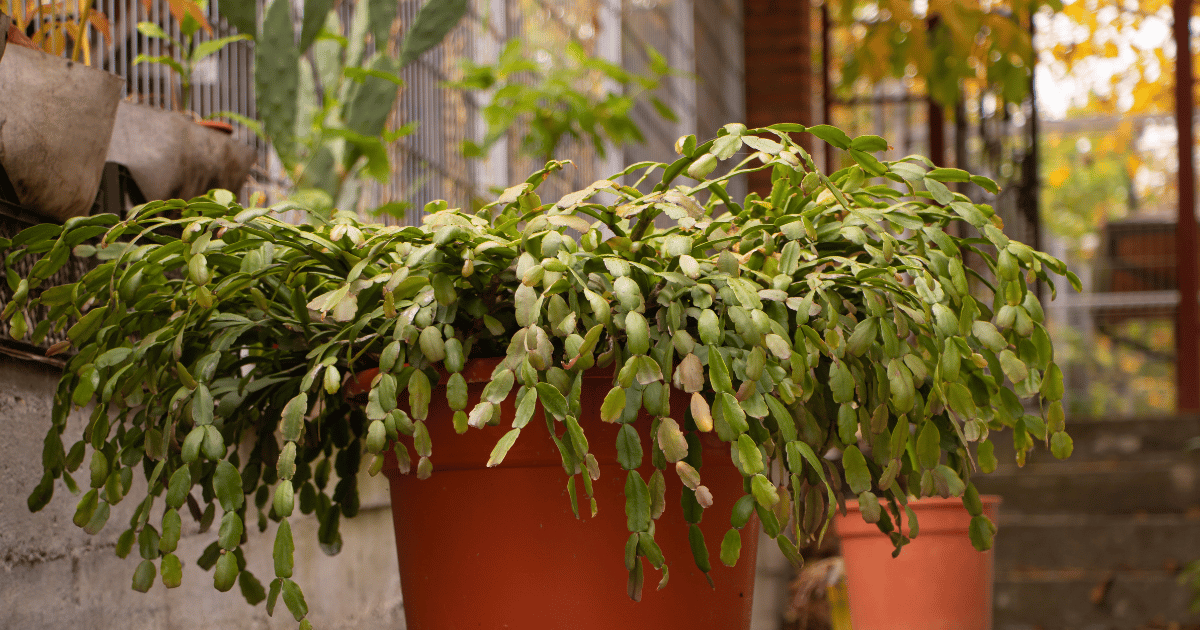The festive allure of a Christmas cactus in full bloom is a sight to behold, but what if your cherished plant remains stubbornly flowerless? The mystery of why your Christmas cactus won’t bloom can be perplexing, leaving you yearning for those vibrant, holiday-inspired blossoms. Fear not as we embark on a journey to demystify this botanical puzzle.
In the following few paragraphs, we’ll unravel the secrets behind the elusive blooms, exploring environmental intricacies, care nuances, and the unique characteristics that make these succulents tick. Get ready to transform your holiday greenery into a flourishing testament of seasonal delight.
Understanding the Christmas Cactus:

Before we troubleshoot the blooming issue, let’s take a moment to appreciate the uniqueness of the Christmas cactus. Belonging to the Schlumbergera genus, these plants are renowned for their segmented stems and stunning flowers. Common varieties include the Thanksgiving cactus and the Easter cactus.
Gaining a deeper understanding of this botanical wonder involves delving into its rich botanical background and recognizing the diversity among common varieties. Whether it’s the Thanksgiving cactus or the Easter cactus, each variant adds a unique touch to your collection.
Join this exploration as we uncover the secrets held within the Christmas cactus, appreciating its distinct charm and setting the stage for cultivating a thriving and blooming succulent during the festive season.
How to Make a Christmas Cactus Bloom?

Follow these steps diligently, and you’ll increase the likelihood of your Christmas cactus gracing your home with a spectacular bloom during the festive season.
Understand Your Christmas Cactus:
- Identify the specific type: Christmas, Thanksgiving, or Easter cactus.
- Learn about its natural blooming period and conditions.
Provide Adequate Light:
- Place the cactus in bright, indirect light.
- Avoid direct sunlight, especially in hot climates.
Maintain Suitable Temperatures:
- Keep temperatures cool to moderate during the blooming phase.
- Avoid extreme temperature fluctuations.
Water Wisely:
- Water thoroughly, but allow the top inch of soil to dry between waterings.
- Adjust watering frequency during the dormant period.
Enhance Humidity:
- Place a tray of water near the plant.
- Use a humidifier, especially in dry indoor environments.
Choose the Right Soil Mix:
- Opt for well-draining potting soil, such as a cactus mix.
- Ensure the pot has drainage holes.
Report When Necessary:
- Repot during the growing season if the plant outgrows its container.
- Refresh the soil to provide essential nutrients.
Follow a Fertilization Schedule:
- Use a balanced, water-soluble fertilizer during the growing season.
- Select a fertilizer with higher phosphorus content to promote flowering.
Prune for Branching:
- Prune after blooming to encourage branching.
- Remove dead or unhealthy segments.
Remove Spent Blooms:
- Deadhead faded flowers to redirect energy for new buds.
- Promotes a fuller and more vigorous bloom.
Simulate Dormancy Period:
- Reduce watering and expose the plant to cooler temperatures for 4-6 weeks.
- Mimic is its natural rest phase.
Check for Pests and Diseases:
- Regularly inspect for pests like spider mites or aphids.
- Treat any issues promptly to avoid stress on the plant.
Be Patient and Consistent:
- Understand that Christmas cacti may take time to adjust and bloom.
- Consistent care and patience are key factors.
- Exchange tips and stories with other Christmas cactus enthusiasts.
- Learn from their successes and challenges.
Celebrate the Blooms:
- Once your Christmas cactus blooms, enjoy the vibrant display.
- Consider incorporating it into your holiday decor.
- If you want to know more details about making your Christmas cactus bloom,
read our article: How To Make a Christmas Cactus Bloom.
What would happen if my cactus were not blooming?
If your Christmas cactus refuses to bloom, several factors might be at play. More light exposure, incorrect temperature conditions, or inconsistent watering may help with blooming. Ensure your cactus receives adequate indirect light, maintains a cool to moderate temperature, and follows a consistent watering schedule. Poor soil quality or lack of proper nutrients can also impact blooming. Assess the plant for pests or diseases that may stress it. Remember, Christmas cacti sometimes require patience, as they might naturally bloom when they’re ready. By addressing these issues and providing optimal care, you increase the chances of enjoying a vibrant display during the holiday season.
Why hasn’t my Christmas cactus bloomed in years?

Several factors may contribute to the prolonged non-blooming of your Christmas cactus, turning it into a perplexing botanical mystery. Consider the following points to understand why your once festive succulent hasn’t graced you with blossoms for years:
Insufficient Light Exposure:
Christmas cacti thrive in bright, indirect light. Inadequate light can impede their blooming ability.
Temperature Extremes:
Extreme temperature fluctuations, especially during the blooming season, may discourage the plant from flowering.
Inconsistent Watering Practices:
Irregular watering, either too much or too little, can stress the plant, affecting its ability to bloom.
Lack of Proper Nutrition:
Christmas cacti require balanced fertilization, with a focus on higher phosphorus content to encourage blooming.
Overcrowded Roots:
Over time, the roots may become overcrowded, hindering nutrient absorption. Repotting during the growing season can address this issue.
Failure to Simulate Dormancy:
Christmas cacti need a dormant period with reduced watering and cooler temperatures. Failure to mimic these conditions may disrupt the blooming cycle.
Pest Infestation:
Pests like spider mites or aphids can stress the plant. Regularly inspect for infestations and treat them promptly.
Genetic Factors:
Some Christmas cacti may have genetic predispositions that affect their blooming frequency. Patience is crucial in such cases.
Environmental Changes:
Significant changes in the plant’s environment, such as a move to a new location or altered light conditions, can cause stress and disrupt blooming.
Long Adjustment Period:
Christmas cacti might take several years to adjust to a new environment before resuming regular blooming.
How do I bring my Christmas cactus back to life?
Reviving a struggling Christmas cactus involves a careful balance of nurturing care. First, assess its environment—ensure it receives bright, indirect light. Adjust watering, keeping the soil consistently moist but not waterlogged. Repot if the soil is depleted. Introduce a balanced, water-soluble fertilizer during the growing season, focusing on higher phosphorus content for blooming. Prune unhealthy segments, and if possible, simulate a dormancy period by reducing watering and providing cooler temperatures for 4-6 weeks. With patience and attentive care, your Christmas cactus can bounce back, displaying its vibrant colors and flourishing once again.
How To Fix A Christmas Cactus That’s Not Blooming

To fix a Christmas cactus that’s not blooming, ensure it receives proper light and temperature conditions. Place it in bright, indirect sunlight and maintain temperatures around 60-70°F. Reduce watering in fall, allowing the soil to dry out between waterings, but keep it slightly moist. Increase humidity by misting or using a humidity tray.
Provide a dark period of at least 12-14 hours nightly for six weeks prior to the blooming season. Ensure it isn’t exposed to drafts or temperature fluctuations. Feed monthly with a balanced, water-soluble fertilizer, but stop feeding in late fall to encourage blooming. Repot only when root-bound, as Christmas cacti bloom better when slightly pot-bound. These adjustments should help your Christmas cactus produce its beautiful flowers.
When Should You Put A Christmas Cactus In The Dark?
Putting a Christmas cactus in the dark is a strategic practice to simulate its natural dormancy period, encouraging healthy blooming. The ideal time to initiate this darkness phase is approximately six weeks before you desire the cactus to flower, typically in late October or early November.
During this period, reduce the exposure of your Christmas cactus to light gradually. Place it in a location with complete darkness for about 12-14 hours each night. This mimics the conditions of its native habitat, where the plant experiences shorter daylight hours.
The darkness signals to the cactus that winter is approaching, prompting it to prepare for blooming. It’s crucial to maintain a consistent schedule during this period, as any interruption or exposure to light can disrupt the dormancy process.
Can I force a cactus to bloom?
While you cannot forcefully make a cactus bloom on command, you can encourage flowering by creating optimal conditions and providing proper care. Christmas cacti, for example, respond well to specific strategies aimed at triggering their natural blooming cycle.
- Simulate Dormancy:
- Introduce a period of darkness for approximately 12-14 hours nightly, typically six weeks before you want the cactus to bloom. This mimics the plant’s natural winter rest.
- Temperature Control:
- Ensure the cactus experiences cooler temperatures during this period, ideally around 50-60°F (10-15°C). This simulates the winter conditions that stimulate blooming.
- Appropriate Watering:
- Adjust the watering schedule to mimic natural conditions. Reduce watering during the darkness phase to promote dormancy.
- Fertilization Strategy:
- Prioritize a balanced, water-soluble fertilizer during the growing season. Choose a fertilizer with higher phosphorus content to enhance bud formation.
- Pruning Practices:
- Prune the cactus after blooming to encourage branching. This promotes more potential bloom sites for the next flowering season.
While these strategies can enhance the likelihood of blooming, it’s important to note that cacti, including Christmas cacti, have their own internal clock. Patience is crucial, as they may take time to respond to changes in their environment. Consistent care and adherence to these practices will contribute to a healthier plant with increased chances of vibrant and abundant blooms during the appropriate season.
Frequently Asked Questions (FAQs)
How often should I water my Christmas cactus?
- Water your Christmas cactus when the top inch of soil feels dry. Ensure thorough watering, allowing excess water to drain.
What is the ideal temperature for a blooming Christmas cactus?
- Keep your Christmas cactus in a cool to moderate temperature range, ideally between 60-70°F during the day and slightly more relaxed at night.
Can I use any fertilizer for my Christmas cactus?
- While any balanced fertilizer works, opt for a formulation with higher phosphorus content during the growing season to encourage blooming.
Why is my Christmas cactus not blooming?
- Several factors, including insufficient light, inconsistent watering, or improper temperature, may hinder blooming. Evaluate and adjust care accordingly.
How long does it take for a Christmas cactus to bloom after dormancy?
- Blooming time varies, but typically, expect flowers about 4-6 weeks after simulating dormancy conditions.
Conclusion
In conclusion, coaxing a Christmas cactus to bloom is a harmonious blend of science and patience. By understanding its unique needs, providing suitable conditions, and mimicking natural cycles, you set the stage for a spectacular floral display. Remember, these resilient succulents operate on their timeline, rewarding your dedicated care with vibrant blooms. Embrace the journey, appreciate the lush greenery, and anticipate the joy that each eventual bloom brings to your festive celebrations. Happy blooming!







